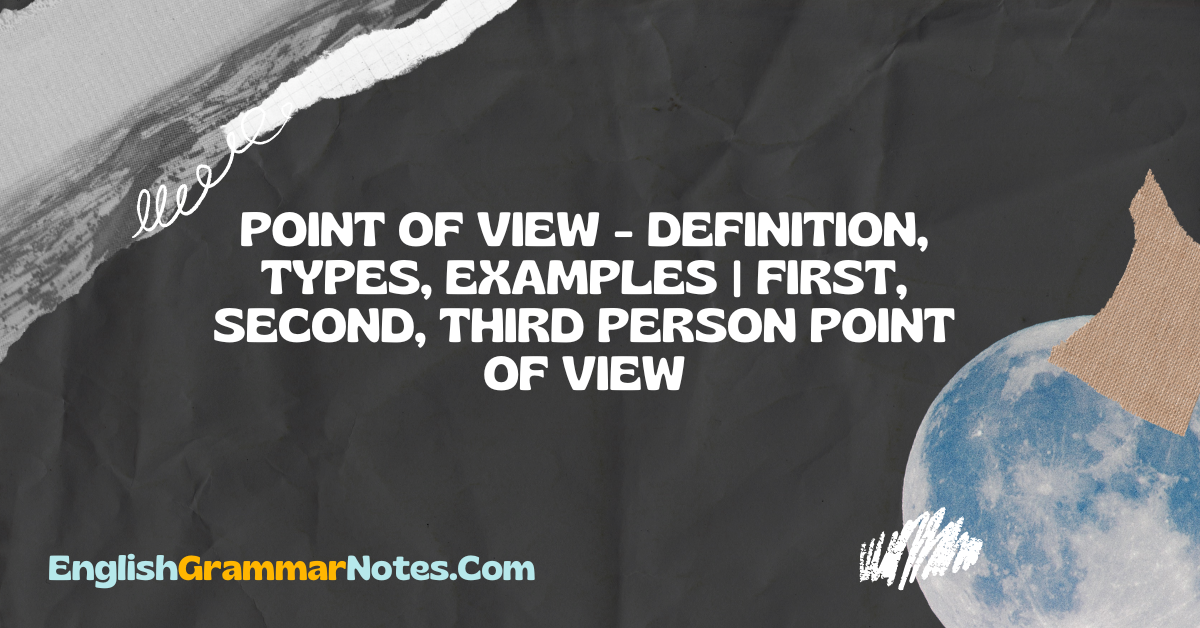Point of view is one of the most significant literary devices used by writers as it governs the reader’s access to the story and governs how much the reader understands any particular moment with regard to what is taking place in the narrative. In this article, you will be introduced to all the essential information about aporia including its definition, common examples, its significance, etc.
- What is a Point of View?
- Point of View Types
- Importance of Point of View
- Point of View Synonyms
- What is a point of view?
- Which are the most commonly used points of view?
- Define a third-person point of view?
- What are some of the synonyms of point of view?
What is a Point of View?
A point of view is a literary device that is used to indicate the angle or perspective from which a story is narrated. It refers to the “eyes” of the narrative voice. Point of View is often employed to reveal emotions.
Point of View Types
Pronouns indicate the point of view used in a work. The most commonly used points of view include first-person, second-person, and third-person points of view.
First Person Point of View
One of the characters in the story will be narrating the events. This viewpoint is expressed by the use of first-person pronouns like “I,”. First-person narrative voice gives the reader a close look into a character’s thoughts, but the use of such a narration is often unreliable as the story is limited by what the character reveals.
Examples:
- I always look forward to spending my free time at the beach. I love to swim in the ocean.
- If I had a choice, I would go for the red one.
This point of view is most commonly used in autobiographies and fiction. Some fictional works that make use of the first person point of view include Jane Eyre, Mony Dick, etc.
Second Person Point of View
Uses the pronoun “you” to address the reader. The second-person point of view intends to bring the readers into the action of the story. However, the use of a second-person point of view is very less. This is because a second-person point of view can exhaust the writer and confuse the reader.
Examples:
In just a few steps you can bring about a great change in your life!
To be a great cook, you must begin your cooking lessons early.
Third Person Point of View
There will be a narrative presence who narrates the story and refers to the characters in the third person, as “he” or “she.” The third-person point of view can be Omniscient, which implies that the narrator is someone who can see and know everything that happens within the story.
Example:
She was looking forward to meeting her friends, but her friends were secretly hoping that the meet would get canceled.
Limited, which implies that the narrator is restricted when it comes to knowing the events happening in the story.
Example:
He was the one who knew all the answers. He scored the highest in the entire class.
Limited Omniscient: Here the third-person narrator can only access the character’s thoughts. He/she might see the other events happening around but can only elaborate on the character’s thoughts.
Some of the literary works that make use of third-person point of view include: Little Women, Lord of the Flies, etc
Alternating Point of View
An alternating point of view is a complex form of narration. While narrating, the narrator can change their view from the first person to the third person or even the second person. The use of this point of view is highly dependent on the setting, situation, and voice of the characters.
Read More:
Importance of Point of View
Point of view is a literary device that is important due to various reasons:
- The point of view helps the reader to understand the character’s thoughts and feelings.
- Understanding the story from different points of view changes the quantity of information that the reader knows.
- The use of certain points of view will also bring in a surprise element for the readers.

Point of View Synonyms
Some of the words closely associated to point of view in meanings include standpoint, outlook, stand, stance, opinion, view, attitude, feeling, sentiment, thoughts, ideas, position, perspective, viewpoint, side, or position.
Boost up your confidence levels while speaking the English Language in classrooms, and in interviews, with the help of our free download English Grammar Notes.
FAQs on Point of View
A point of view is a literary device that is used to indicate the angle or perspective from which a story is narrated. It refers to the “eyes” of the narrative voice.
2. Which are the most commonly used points of view?
The most commonly used points of view are the first person point of view and the third person point of view.
3. Define a third-person point of view?
From a third-person point of view, there will be a narrative presence who narrates the story and refers to the characters in the third person, as “he” or “she”.
4. What are some of the synonyms of point of view?
Some of the words closely associated to point of view in meanings include standpoint, outlook, stand, stance, opinion, etc.
Conclusion
The point of view is a literary device that has an important role in writing. The use of the right point of view makes a story interesting and unique. Having an idea of the different types of points of view and when to use them will surely make your writing stronger. On the whole, the use of point of view indicates how you want to convey the events in the story to the reader. However, remember to stay consistent and stick to one point of view throughout.
